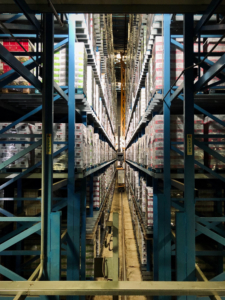
Before the labor shortage and supply chain problems began — even before the pandemic that fueled them started — automation was a buzzword for planners and public officials. Now, automation may be the public sector’s best bet for dealing with stifling setbacks to the global supply chain.
The term, automation, refers to any system that uses sensors and controls to complete a particular action without human involvement and, conversely, without human error. Automation is a trend that is significantly impacting most aspects of the economy and especially the government marketplace.
In California, diverse automation needs will yield numerous opportunities for companies providing automation offerings. California’s state assembly recently approved one-time funding of $500,000 to evaluate the impact of automation on employment and the environment. The project will help state officials evaluate the benefits of a widescale shift to automation at the ports of Los Angeles and Long Beach. Findings from the study will then be released toward the end of July 2023, and plans related to additional automation services will be announced.
 The city of Palo Alto, California, is also fertile ground for automation opportunities. City leaders have planned one $2.7 million automation project to manage the city’s parking resources more efficiently. Design work on another automated parking guidance system will begin soon. This second project will be designed to mitigate congestion in the downtown area. Another previously delayed automation upgrade at the Palo Alto airport is scheduled to begin later this summer. Installation of an Automated Weather Observation System (AWOS) at the airport will cost $607,000 with approximately 90 percent of the funding covered by a Federal Aviation Administration (FAA) grant program. The AWOS will replace outdated technology and ensure accurate and real-time weather reporting.
The city of Palo Alto, California, is also fertile ground for automation opportunities. City leaders have planned one $2.7 million automation project to manage the city’s parking resources more efficiently. Design work on another automated parking guidance system will begin soon. This second project will be designed to mitigate congestion in the downtown area. Another previously delayed automation upgrade at the Palo Alto airport is scheduled to begin later this summer. Installation of an Automated Weather Observation System (AWOS) at the airport will cost $607,000 with approximately 90 percent of the funding covered by a Federal Aviation Administration (FAA) grant program. The AWOS will replace outdated technology and ensure accurate and real-time weather reporting.
Madison, Wisconsin is launching an automation opportunity promoting environmental sustainability. The city announced an initiative to outfit all city-owned buildings with automation upgrades including solar panels and LED lighting over the next several years. Automation equipment will determine how much energy is required for each building based on data sensors gather on when and how the building is used. The city will seed the project with $4.7 million and allocate $2 million annually until 2027.
Private automation specialists can find numerous immediate automation-related opportunities across multiple counties in Minnesota. In Hennepin County, local officials plan to upgrade 63 county-owned buildings with automation systems. Ramsey County also will install automation systems with one of the first projects involving the Ramsey County Care Center. The center’s automation system will allow more efficient monitoring of HVAC, lighting, and safety components. The technology will allow the county to reduce expenses, consume fewer resources, and become less dependent on an unpredictable supply chain.
Plans to make automation upgrades to municipal buildings in Naperville, Illinois, have been announced. One immediate automation project will begin at the Naperville North High School campus. An initial funding allocation has been approved, and another $365,000 is available for more automation upgrades.
Officials in New York’s Orange County also are launching automation projects. The county’s transportation council recently announced plans that include a $3.9 million automation contract to provide a countywide traffic data system that will use automated data capture technology. That procurement process is planned for May.
Orlando, Florida, soon will launch a procurement to secure new automation services in one of the city’s iconic landmarks. The current contract for building automation maintenance at Amway Center, home of the NBA’s Orlando Magic, will expire in September, and a new contract will be procured.
The trend toward automation also is creating opportunities in Yakima, Washington. Approval was recently granted for a $130,000 capital improvement project at the Yakima airport that will include automation technology. An automated security exit lane will be installed that will allow passengers to exit the concourse without assistance or monitoring from airport staff. Similar projects have recently been completed in other nearby airports including Seattle-Tacoma International and Pangborn Memorial.
The city of Cincinnati is encouraging a range of automation measures. Upcoming capital improvements include a $3 million project to automate sewage flow. The city will replace an underflow pipe, add level sensors, and install telemetry equipment for a sewer system in the Little Miami basin between Linwood and Madisonville neighborhoods. Cincinnati also will invest $200,000 this year in a new automated pump monitoring program to identify malfunctions in the city’s water facilities before damage is done. More automation opportunities will be available in the city’s enterprise data warehouse project which will begin in 2022 with a $195,000 investment to license automation software. Over the following years, the software will be applied across all departments for data discovery and analysis purposes.
In Alexandria, Virginia, an automation project shelved in 2021 has been restored that carries an estimated cost of $420,000. The project will replace the Alexandria Police Department’s manual system for writing up and reporting of traffic citations. New software will be procured to fully digitize and automate ticketing procedures that begins with each initial ticket and continues through the court process.
Automation systems eventually will become common components of all types of projects. The burgeoning technology offers so many alert systems, safety benefits, and efficiency options, it will be almost impossible to exclude it from any project. This trend is truly worth monitoring.
